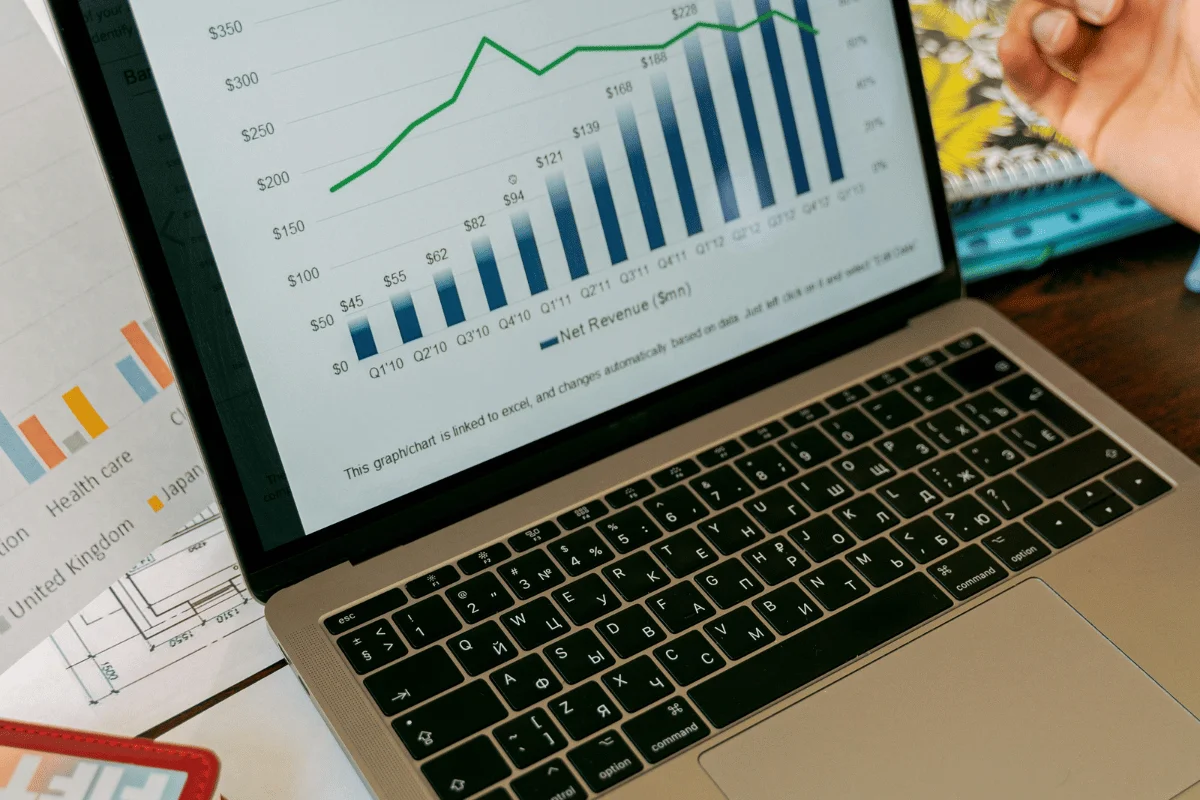Determining the economic value of a SaaS company is beneficial for understanding its growth potential and profitability, whether you’re looking to sell to expand to a new market or aiming to scale.
However, valuation is never straightforward, nor are its determining metrics an exact science.
In fact, valuation multiples are mere ballpark estimates, not exact measures of how much a company is worth.
In this article, we will help you navigate the complex concept of SaaS valuation–from explaining valuation metrics to understanding the role of external advisors in attaining an accurate evaluation.

The growth rate of a company indicates its future revenue potential, making it a critical factor in investment and acquisition scenarios.
Other key roles of growth rate in SaaS valuation include:
Here’s how you can calculate your revenue growth rate:

For example, if your company generated $4 million this year compared to $3.2 million last year, your yearly growth rate would be:
[($4,000,000 - $3,200,000) / $3,200,000] x 100 = 25%
Losing customers isn’t the only adverse effect brought by churn.
Follow the steps below to understand the real impact caused by churn on SaaS valuation:
Before evaluating any impact, you need to be crystal clear on what “churn” means for your product or service. For a mobile app, churn may be as simple as uninstallation of the app. But for a subscription service, churn might mean cancellation of a subscription.
By defining churn, businesses can identify and track the right metrics, such as Customer Retention Rate (CRR) and Customer Churn Rate.
Pay close attention to business valuation metrics that are directly influenced by your ability to retain customers.
They include:
To quantify the impact of each churned account, subtract the revenue a customer generated from their estimated lifetime value.
A high churn rate impacts growth negatively since every customer you acquire replaces a lost one rather than contributing to the company’s growth.

Market trends and industry benchmarks are indispensable factors in SaaS valuation because they help investors and buyers determine whether your company is a top performer, a laggard, or average.
Let’s look at how you can factor them in when doing a valuation and selling your SaaS company:

For SaaS companies, Intellectual Property (IP) is a fundamental driver of their worth.
A solid portfolio of intellectual property directly impacts valuation metrics by:

There are three main ways to perform a SaaS company valuation: revenue or ARR-based, EBITDA-based, and SDE-based.
Let’s dig deeper.
Revenue-based or Annual Recurring Revenue (ARR) valuation focuses on potential growth. The other two, on the other hand, look mainly at profits and earnings.
Most private SaaS companies prefer this approach because they make significant upfront expenses while investing in growth. Hence, current numbers may not support an objective forecast of profitability.
So they focus instead on determining their growth outlook, assuming that the higher the growth potential, the higher the company’s value.
What is a Multiplier in Business?
Multipliers, also known as the price-to-earnings (P/E) ratio or earnings multipliers, are used in valuations to determine the actual value of a company.
Smaller businesses typically have multipliers of one to three, while larger and more established ones can have four or higher.
Factors that affect multipliers include the following:
To determine your current multiplier:
For example:
$4,000,000 (enterprise value) ÷ $2,000,000 (earnings)
= 2 (current multiplier)
To calculate projected business value:
For example:
$4,000,000 (EBIT) ✕ 2 (average industry multiplier)
= $8,000,000 (business value)
What is NTM Revenue?
NTM revenue (also called “forward revenue”) is a company’s forecasted revenue over the next twelve months.
Businesses valued for their growth potential, such as SaaS companies and startups, are often valued based on their NTM because much of their real value is yet to be seen.

EBITDA stands for “earnings before interest, taxes, depreciation, and amortization”.
This valuation model is used mainly for larger enterprises with a complex management structure or those with an earning power of $5 million or higher.
It determines a company’s economic value based on its financial stability by looking at cash flow minus operational obligations and taxes.
How Many Times EBITDA is a Business Worth?
Businesses are generally valued anywhere from three to six times a company’s EBITDA. Several factors influence valuation in this case, such as:
Businesses with a high growth potential or that operate in a fast-growing market may benefit from conducting EBITDA-based valuations, as the end figures are typically much higher than their net income.
The main reason is that EBITDA factors back into a business’s actual value its non-cash and recurring expenses, depreciation, and amortization.
However, because EBITDA can present an inflated picture of a company’s worth, most buyers will negotiate for a lower value when striking a deal.
The SDE or Seller Discretionary Earnings valuation method works best for smaller businesses with an ARR of less than $5 million that operate with and rely heavily on a single owner.
Compared with EBITDA valuation, which looks at overall financial performance, SDE valuation measures revenue generation efficiency per employee.
With this approach, the amount that owners pay themselves as a salary is considered to determine a company’s earning capacity accurately.
Unsure how to calculate your company’s value? Try using Exitwise’s Business Valuation Calculator to understand your company’s mergers and acquisitions (M&A) transaction value in real-time.

The general rule of thumb when appraising a business is to weigh in on industry-specific multiples such as EBITDA, revenue, and discretionary earnings to arrive at an estimated value of a company.
It’s important to note that while these are helpful for business owners to gain a high-level overview of their company’s value, there is no one-size-fits-all approach.
Every enterprise is unique. Many factors outside of revenue and earnings affect the actual value of a company, such as the business model, its unique value proposition, and intellectual property.
A combination of several valuation approaches may be necessary to gain a clearer, more accurate picture.
SaaS valuation multiples are factors by which revenue is multiplied to arrive at a ballpark estimate of a company’s value.
Using the multiples approach in SaaS business valuation, we can compare similar businesses by evaluating them using standard financial metrics.
Types of Valuation Multiples
There are two types of valuation multiples:
Since equity value is impacted by changes in capital structure, enterprise multiples are often regarded as more accurate tools for determining market value.
Equity multiples, on the other hand, are easier valuation models because they rely on readily available financial data.
Methods for Using Multiples in Valuation
There are two ways to use valuation multiples when determining a company’s market value:
How Do Early-Stage SaaS Valuation Multiples Differ?
Valuing an early-stage company is unique because most valuation models don’t apply. During the initial stages of business, companies are yet to see profits and are instead actively investing in growth.
Financial performance indicators, such as historical data, are also insufficient and can’t provide a clear picture of a company’s status.
Therefore, qualitative elements, like management experience, play a significant role in the valuation process. A company’s scalability, business model, and market are other factors that affect valuation.
The most common early-stage SaaS valuation multiples include enterprise value-to-EBITDA and enterprise value-to-revenue.

To get a more accurate picture of a company’s worth, it’s essential to use more than one SaaS valuation method.
Here’s how:
First, select a primary valuation method that suits your company’s stage and financial profile. For high-growth companies, focus on the ARR-based approach, since such companies invest heavily in marketing and typically register minimal profits.
For mature, profitable companies, the EBITDA-based approach becomes more relevant, especially for companies valued over $5M with revenue reaching up to $2M. For small, owner-operated businesses, the SDE-based approach is the clear choice because it accounts for small businesses that are worth less than $5 million and still depend on the owner to operate.
Once you’ve chosen a primary valuation method, back it up with at least one other method to get a well-rounded perspective.
For instance, if you have a profitable SaaS company, comparing your EBITDA and ARR multiples can reveal hidden facts. If your ARR score is higher than your EBITDA score, it may signal that your company’s growth is not fully reflected in your current earnings.
This comprehensive view gives you a defensible valuation range and presents a compelling case for a higher valuation.
After applying at least two valuation methods, you should weigh the pros and cons of each approach. One method might capture your business growth potential better, while the other might provide a detailed view of your current performance.
Review these factors to determine a reasonable valuation range. For example, if your ARR-based valuation is $4 million and your EBITDA-based valuation is $3 million, your defensible valuation range is between $3 million and $4 million.
The valuation is realistic, and you can defend it before investors or buyers.

SaaS valuations are complex processes affected by a myriad of factors. The following are some of the most common metrics that affect a company’s market value:

Whichever valuation model you use, the following financial metrics are key indicators of your company’s value:
Whether you’re looking to buy or sell (or even if you’re simply trying to gauge the health of your business), knowing how to value a SaaS company is crucial for understanding a business’s overall financial condition.
You can conduct a surface-level valuation yourself, but you need experts to get a more accurate picture of what your business is worth.
Valuations are a complex, multi-disciplinary process that requires the aptitude and knowledge of industry professionals or expert business valuers.
You’ll need M&A advisors, corporate lawyers, and investment bankers to create a successful exit strategy. These experts take care of each stage of M&A transactions–from preparation and planning to conducting due diligence and documentation.
Every step of the M&A process is time-consuming and meticulous work that requires acute knowledge of the playing field and understanding how to market a business to the right prospects.
The right M&A team will not only help you increase your chances of receiving better offers but also protect the confidentiality of your data and ensure a smooth sales process.
If you’re trying to develop a successful exit strategy, Exitwise can help you build a team of M&A experts who can maximize the sale of your business.
Chat with an Exitwise team member today to know how!

Now that you know how to value your SaaS company, the next step is to build a healthy and sustainable business that's worth even more.
Here’s how you can do just that:
To get a high valuation, you must track and optimize SaaS valuation metrics that provide insights into the health and overall value of your business.
You can do this by:
Beyond the metrics, you need to show VCs that your company is a solid, well-run operation.
Here’s how you can do that:
Potential buyers and investors will have a deep dive into your company documents before making any decision.
It’s therefore essential for you to clear up any red flags by:

We’ve addressed some of the most commonly asked questions about valuations for SaaS companies below:
Entrepreneur and venture capitalist Brad Feld popularized the Rule of 40 in SaaS valuations.
It states that for a SaaS company to be successful, it should have a combined growth rate and profit margin of 40% or more.
For example, if your company is growing at a rate of 30%, your profit margin should at least be 10%.
According to this rule, businesses growing at a rate of 40% can have a 0% profit margin and still be viable. Those growing at an even higher rate (say, 50%) can afford to lose a percentage of their revenue.
Slowing down growth may result in higher profit margins. However, it may take businesses longer to scale.
Valuation multiples for early-stage SaaS companies differ from those for more established enterprises because very little historical data can form a solid basis for their financial performance.
Therefore, valuations for pre-revenue outfits often look at their growth potential and exit value using multiples like EV/Revenue and ARR.
Qualitative indicators, like management experience and customer base, are also considered to form a more rounded picture of a company's status.
Understanding a SaaS company's value and growth potential is complicated work.
It requires a thorough analysis of various aspects of business–from figuring out which valuation models work best to applying the right multiples.
You need industry professionals' expertise to maximize your business's sale and ensure a win-win valuation process.
Jumpstart your exit strategy today. Get in touch with Exitwise advisors to set up your dream team of M&A experts!
Let Exitwise introduce, hire and manage the best, industry specialized, investment bankers, M&A attorneys, tax accountants and other M&A advisors to help you maximize the sale of your business.

